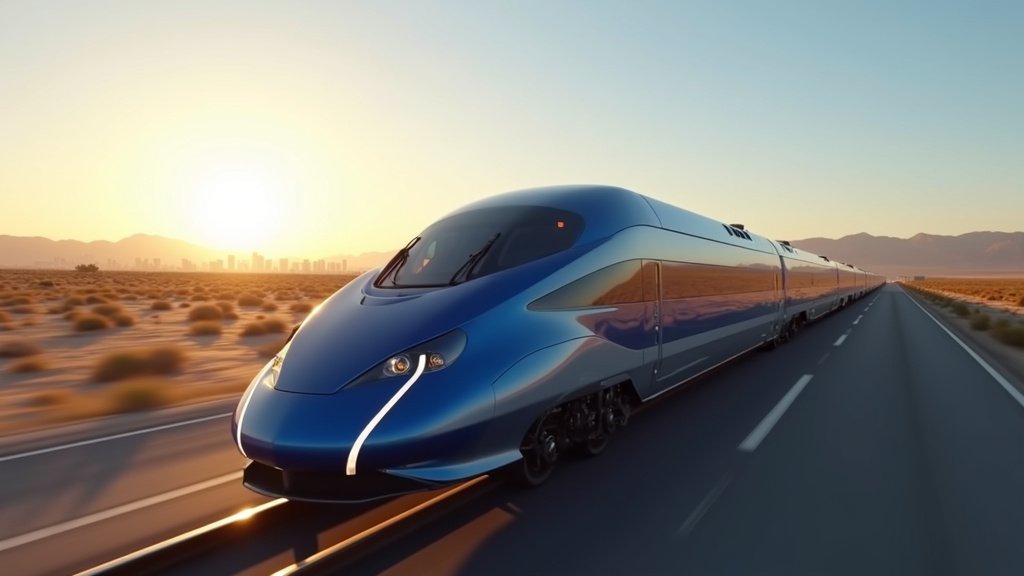The ambitious Brightline West high-speed rail project, aiming to connect Southern California with Las Vegas, is making significant strides by strategically employing cost-saving measures, primarily by utilizing the median of Interstate 15 (I-15) and establishing its Southern California terminus outside the dense urban core of Los Angeles. This innovative approach seeks to overcome the considerable financial hurdles inherent in building U.S. high-speed rail infrastructure while addressing the persistent traffic congestion between two of the nation’s most popular destinations.
Connecting Two Iconic Destinations
Brightline West envisions a 218-mile all-electric passenger rail line that will dramatically reduce travel times between Las Vegas and the Greater Los Angeles area. With trains capable of reaching speeds of up to 200 miles per hour, the journey from Las Vegas to Rancho Cucamonga, California, is expected to take approximately two hours and ten minutes, cutting current driving times by more than half. The project, which officially broke ground in April 2024, is a key initiative by Brightline, a private company known for its Florida passenger rail service, and is positioned as the first true high-speed rail system in the United States. The goal is to offer a faster, greener, and more reliable alternative to the estimated 50 million annual trips between the two regions, over 85% of which are currently made by car, often resulting in arduous traffic jams along the I-15 corridor.
Strategic Cost-Saving Measures
High-speed rail projects in the U.S. have historically faced challenges due to escalating costs, often exacerbated by complex land acquisition processes and extensive urban construction. To counter this, Brightline West has adopted a pragmatic route strategy. A significant portion of the 218-mile line will be constructed within the median of the I-15 highway, a decision that drastically reduces the need for costly land acquisition from private owners, a major expense that has plagued other large-scale U.S. rail projects.
Furthermore, the choice of Rancho Cucamonga as the Southern California terminus, located approximately 40 miles east of downtown Los Angeles, is another key cost-saving measure. This location avoids the exorbitant expense of building through highly developed urban areas and allows for seamless integration with Southern California’s existing Metrolink commuter rail network. This connectivity enables passengers from downtown Los Angeles and other surrounding counties to reach Las Vegas via a single ticket purchased through Metrolink. The project also includes intermediate stops in Victor Valley and Hesperia, California.
Funding and Partnerships
The $10 billion to $16 billion project is being financed through a combination of private investment and significant federal support. In December 2023, the U.S. Department of Transportation awarded Brightline West a $3 billion grant as part of the Bipartisan Infrastructure Law, with additional support coming from $2.5 billion in private activity bonds approved by the U.S. DOT. The company is also actively pursuing additional equity and refinancing debt to cover the total project costs. Key partners include the Nevada Department of Transportation (NDOT), the California Department of Transportation (Caltrans), and the San Bernardino County Transportation Authority (SBCTA), which is facilitating the Rancho Cucamonga station. The project also leverages partnerships with construction firms and labor unions, emphasizing union worker participation.
Environmental and Economic Impact
Brightline West is designed as a fully electric, zero-emission system, powered by an overhead catenary system. This commitment to sustainability is projected to remove over 400,000 tons of carbon pollution annually, making it one of the greenest forms of transportation in the United States. Economically, the project is expected to be a significant job creator, generating an estimated 35,000 jobs during its four-year construction phase, including over 10,000 direct union construction roles. Upon completion, it is anticipated to support around 800 permanent operational jobs. The increased connectivity is also expected to boost tourism to Las Vegas and stimulate economic development in the served regions.
Looking Ahead: Challenges and Outlook
Despite its strategic cost-saving measures and robust funding, Brightline West faces the inherent challenges of large-scale infrastructure development, including rising labor and material costs. While the project broke ground in April 2024, heavy construction is expected to ramp up, with a target completion date for late 2028, too late for the initial aspiration of the 2028 Los Angeles Olympics. Skeptics and financial analysts have raised concerns about project timelines and revenue projections, citing potential financial challenges, similar to those encountered by Brightline’s Florida service. Nevertheless, supporters, including former Transportation Secretary Pete Buttigieg, view Brightline West as a crucial step in advancing high-speed rail in the U.S., potentially serving as a model for future projects. The project’s success hinges on its ability to navigate these final construction and financing stages while delivering on its promise of efficient, sustainable, and affordable travel between Southern California and the popular destination of Las Vegas.





